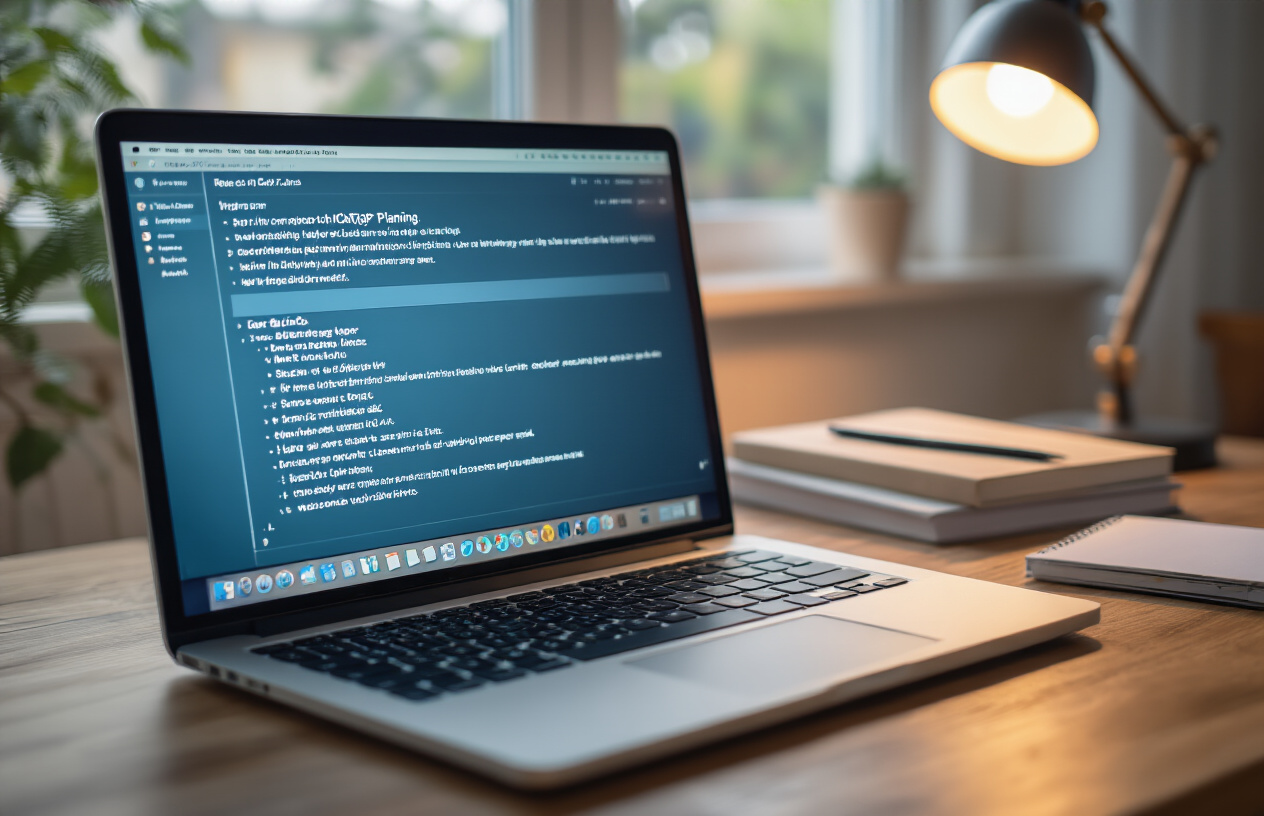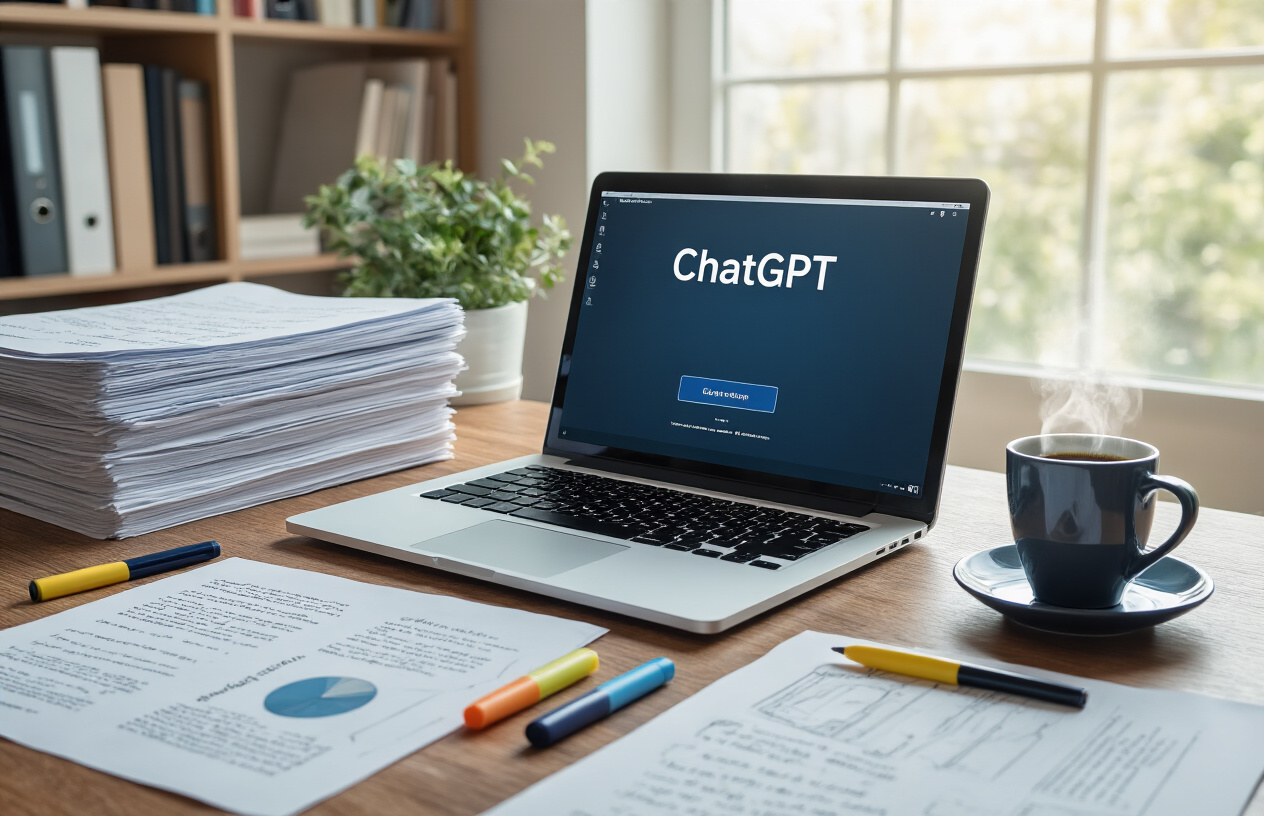Writing a research paper outline can feel overwhelming, but ChatGPT makes this essential step much easier and faster. This guide is perfect for students, researchers, and academic writers who want to streamline their planning process and create well-structured outlines without starting from scratch.
ChatGPT excels at organizing complex information and breaking down broad topics into manageable sections. With the right approach, you can transform your research ideas into a clear, logical framework that guides your entire writing process.
We’ll walk you through crafting effective prompts that get you the best outline results from ChatGPT. You’ll also learn how to refine and customize the AI-generated structure to match your specific requirements and academic standards. By the end, you’ll have a proven system for turning ChatGPT into your personal outline assistant.
Understanding ChatGPT’s Capabilities for Research Paper Planning

Recognizing AI-powered outline generation benefits
ChatGPT brings remarkable speed to the traditionally time-consuming process of creating research paper outlines. Instead of spending hours or even days mapping out your paper’s structure, you can generate comprehensive frameworks in minutes. This acceleration allows you to dedicate more time to actual research, analysis, and writing.
The AI excels at identifying logical connections between different aspects of your topic. When you provide your research question or thesis statement, ChatGPT can spot relationships and hierarchies that might not be immediately obvious. It draws from its vast knowledge base to suggest relevant subtopics, supporting arguments, and potential counterpoints that strengthen your paper’s foundation.
ChatGPT also offers fresh perspectives on familiar topics. Academic writers often get tunnel vision, focusing narrowly on their chosen angle while missing broader contexts. The AI can propose alternative approaches, suggest interdisciplinary connections, and highlight aspects of your topic you hadn’t considered. This broader view often leads to more comprehensive and engaging research papers.
The tool provides consistent formatting and organization standards. Academic writing demands specific structural elements, and ChatGPT understands these conventions. It can generate outlines that follow standard academic formats while ensuring proper hierarchy and flow between sections.
Identifying ChatGPT’s strengths in academic writing assistance
ChatGPT demonstrates exceptional ability in breaking down complex research topics into manageable components. Whether you’re tackling a broad subject like climate change or a narrow focus like 18th-century poetry, the AI can dissect your topic into logical sections and subsections that create a clear roadmap for your research and writing process.
The AI’s strength lies in its capacity to maintain coherent argumentation throughout outline structures. It understands how different sections should build upon each other, creating natural transitions and ensuring that each part of your paper serves the overall thesis. This systematic approach prevents the common problem of disjointed papers where sections feel disconnected from the main argument.
ChatGPT excels at suggesting relevant research directions and potential sources. While it won’t provide specific citations, it can identify the types of evidence you’ll need, suggest methodological approaches, and point you toward relevant fields of study. This guidance proves invaluable during the early stages of research planning.
The AI also adapts to different academic disciplines and writing styles. Whether you’re crafting a scientific report, literary analysis, or historical research paper, ChatGPT can adjust its suggestions to match disciplinary conventions and expectations.
Understanding limitations and human oversight requirements
ChatGPT cannot replace critical thinking and subject matter expertise. While it generates structurally sound outlines, you must evaluate whether the suggested organization truly serves your specific research goals and arguments. The AI might miss nuances in your field or fail to recognize the significance of particular theoretical frameworks that are crucial to your work.
The tool lacks access to current research and real-time information. ChatGPT’s knowledge has cutoff dates, meaning it cannot incorporate the latest studies, recent developments, or emerging debates in your field. You’ll need to update and revise AI-generated outlines to reflect current scholarship and contemporary issues.
Fact-checking remains your responsibility. ChatGPT occasionally generates plausible-sounding but inaccurate information. Every claim, statistic, or historical reference in your AI-generated outline requires verification through credible academic sources before inclusion in your final paper.
The AI cannot assess the availability or quality of sources for your specific research context. It might suggest research directions that are impossible to pursue given your institutional access, time constraints, or available resources. Human judgment is essential for determining feasibility and adjusting expectations accordingly.
ChatGPT also cannot evaluate the originality or significance of your research contribution. While it can help organize your ideas, determining whether your approach offers genuine insights or advances knowledge in your field requires human expertise and familiarity with existing scholarship.
Preparing Your Research Topic for ChatGPT Input

Defining your research question clearly
Before you can get ChatGPT to help create a stellar outline, you need to nail down exactly what you’re trying to explore or prove. A vague topic like “climate change” won’t cut it – ChatGPT needs something specific to work with. Transform broad subjects into focused research questions that can actually be answered within your paper’s scope.
Start by identifying the core issue you want to address. Are you examining the economic impacts of renewable energy adoption in developing countries? Analyzing how social media influences political participation among Gen Z voters? The more precise your question, the better ChatGPT can structure your outline around a logical argument.
Your research question should be debatable rather than factual. Instead of “What is artificial intelligence?” try “How will AI automation affect middle-class employment opportunities in the next decade?” This approach gives ChatGPT clear direction for organizing arguments, counterarguments, and supporting evidence throughout your outline.
Gathering preliminary sources and key concepts
Strong research papers build on existing knowledge, so collect your foundational sources before engaging ChatGPT. You don’t need exhaustive research at this stage – just enough material to understand the current conversation around your topic.
Look for recent academic articles, reputable news sources, and authoritative books that relate to your research question. Pay attention to recurring themes, debates, and terminology that experts use when discussing your subject. These patterns will help you communicate effectively with ChatGPT about your field’s specific language and concerns.
Create a running list of key concepts, technical terms, and influential scholars in your area. When you mention these elements in your ChatGPT prompts, the AI can incorporate field-appropriate vocabulary and structure into your outline, making it sound more professional and academically grounded.
Organizing background information effectively
ChatGPT works best when you can provide context about your research landscape. Organize your preliminary findings into clear categories that highlight different perspectives, methodologies, or time periods relevant to your question.
Group your sources by themes rather than dumping everything together. For instance, if you’re researching urban planning, you might separate sources into categories like “sustainable development approaches,” “community engagement strategies,” and “economic considerations.” This organization helps you explain to ChatGPT how different pieces of your research connect.
Write brief summaries of major viewpoints or schools of thought in your field. When you can tell ChatGPT that “scholars generally fall into three camps regarding this issue,” you enable the AI to structure your outline around these existing frameworks rather than creating something generic.
Setting specific outline parameters and requirements
ChatGPT can generate countless outline variations, but you need to establish boundaries that match your assignment requirements and personal goals. Be explicit about format expectations, length constraints, and structural preferences.
Specify whether you need a traditional five-paragraph essay structure, a more complex argument with multiple sections, or something that follows specific disciplinary conventions. Include details about required elements like literature reviews, methodology sections, or case studies that must appear in your outline.
Consider your audience and purpose when setting parameters. An outline for a senior thesis will look different from one designed for a freshman composition course. Tell ChatGPT about your target audience, desired tone, and the type of evidence that will be most persuasive for your readers. This context ensures the generated outline serves your specific academic and rhetorical needs.
Crafting Effective Prompts for Outline Generation

Writing clear and detailed prompt instructions
The quality of your research paper outline depends heavily on how well you communicate with ChatGPT. Think of your prompt as a conversation starter where you need to be specific about what you want. Instead of asking “Help me write an outline,” provide context about your research paper’s purpose and requirements.
Start by explaining your assignment details. Include information like the paper’s length, your academic level, and the specific requirements from your instructor. For example, “I need to create an outline for a 10-page undergraduate research paper analyzing the impact of social media on teenage mental health for my Psychology 101 class.”
Be explicit about the structure you want. If you need a traditional five-paragraph essay format, say so. If you’re working on a longer research paper that requires multiple main sections with subsections, specify that structure. ChatGPT can generate various outline formats, but it needs to know which one matches your needs.
Include details about your target audience. Writing for high school students requires a different approach than writing for graduate-level peers or academic professionals. This context helps ChatGPT suggest appropriate language complexity and depth of analysis.
Don’t forget to mention any specific elements your outline must include. Some assignments require literature review sections, methodology discussions, or counterargument paragraphs. The more details you provide upfront, the better ChatGPT can tailor its suggestions to match your exact requirements.
Specifying academic format and citation style preferences
ChatGPT can adapt its outline suggestions to match different academic formats, but you need to tell it which style guide to follow. Whether you’re using APA, MLA, Chicago, or another citation format, mention this in your initial prompt. Each style has different expectations for paper structure and section organization.
APA format typically requires specific sections like an abstract, introduction, literature review, methodology, results, discussion, and references. If you’re writing in APA style, ChatGPT can structure your outline to include these standard sections and suggest appropriate subheadings within each main section.
MLA format often focuses on argument development and textual analysis, especially for literature and humanities papers. When you specify MLA format, ChatGPT can emphasize thesis development, evidence presentation, and analysis sections that work well for this style.
Beyond citation style, mention any discipline-specific requirements. Science papers often need hypothesis sections and data analysis components. History papers might require chronological organization or primary source analysis sections. Business papers could need executive summaries and recommendation sections.
Ask ChatGPT to include formatting reminders in your outline. For instance, it can note where you’ll need in-text citations, where to place your thesis statement, or how to structure your bibliography. These reminders help you stay organized as you move from outline to full draft.
Including topic scope and depth requirements
Your research topic’s scope directly affects your outline’s structure, so be clear about how broad or narrow your focus needs to be. A paper about “climate change” covers different ground than one about “carbon emissions from transportation in urban areas during 2020-2023.” The more specific your scope, the more targeted ChatGPT’s outline suggestions can be.
Explain your paper’s depth requirements. An introductory survey paper needs different organization than an in-depth analysis or original research project. If you’re writing a comprehensive overview, ChatGPT can suggest broader main points with multiple subtopics. For focused analysis papers, it can recommend fewer main sections with deeper subdivision.
Consider your research boundaries and mention them in your prompt. If you’re limited to certain time periods, geographic regions, or specific populations, include these constraints. ChatGPT can then structure your outline to address these parameters systematically rather than suggesting sections that fall outside your scope.
Address the balance between breadth and depth that your assignment requires. Some papers need to cover many aspects of a topic briefly, while others require detailed exploration of fewer elements. This balance affects whether your outline should have many main sections with brief subsections or fewer main sections with extensive subdivision.
Be honest about your knowledge level and research stage. If you’re still learning about your topic, ask ChatGPT to suggest sections that help you explore different angles. If you already have strong opinions or findings, request an outline structure that supports argument development and evidence presentation.
Generating Your Initial Research Paper Structure

Requesting comprehensive outline frameworks
Start by asking ChatGPT for a complete structural blueprint of your research paper. The key is being specific about your academic level and paper type. Try prompts like “Create a detailed outline for a 15-page undergraduate research paper on renewable energy policy” or “Generate a comprehensive structure for a graduate-level analysis of social media’s impact on political discourse.”
ChatGPT excels at providing multi-tiered outlines that include main sections, subsections, and even bullet points for key arguments. Ask for different framework options by requesting “three different structural approaches” to your topic. This gives you flexibility to choose the organization that best fits your research goals and available sources.
Don’t settle for generic templates. Request discipline-specific formats by specifying your field: “Create an outline using standard political science paper structure” or “Generate a psychology research paper framework following APA guidelines.” This approach ensures your outline matches academic conventions in your area of study.
Obtaining section-by-section breakdowns
Once you have your main framework, drill down into each section for detailed breakdowns. Ask ChatGPT to expand specific parts of your outline with prompts like “Elaborate on the literature review section with specific subsections and key points to cover” or “Break down the methodology section into detailed components with suggested word counts.”
Request paragraph-level guidance for complex sections. For example, “Provide a paragraph-by-paragraph breakdown of the introduction, including what each paragraph should accomplish.” This granular approach helps you understand exactly what content belongs where and prevents overlap between sections.
Create section-specific checklists by asking “What essential elements must be included in the results section?” or “List the critical components for a strong conclusion chapter.” These breakdowns serve as quality control measures as you write.
Securing relevant subtopic suggestions
Transform broad topics into focused subtopics by leveraging ChatGPT’s ability to identify specific angles and perspectives. Use prompts like “Suggest five specific subtopics within climate change adaptation strategies” or “Identify unique angles for analyzing the gig economy’s labor implications.”
Ask for subtopic hierarchies that show relationships between different aspects of your research. Request something like “Organize these subtopics from most to least important” or “Show how these subtopics connect to create a logical argument flow.” This helps you prioritize your research efforts and allocate appropriate space to each subtopic.
Generate subtopic questions that guide your research direction. Prompt ChatGPT with “Create research questions for each subtopic that would strengthen my overall argument.” These questions become roadmaps for finding relevant sources and developing compelling arguments.
Getting logical flow recommendations
Smooth transitions between ideas make or break research papers. Ask ChatGPT to evaluate your outline’s logical progression with prompts like “Does this section order create a compelling argument flow?” or “Suggest improvements to make the transition from literature review to methodology more natural.”
Request connection maps that show how each section relates to your thesis. Try “Explain how each outline section supports my main argument” or “Identify potential gaps in my logical progression.” This reveals weak spots in your argument structure before you start writing.
Get specific transition strategies by asking “Suggest three ways to connect the historical context section to the current policy analysis” or “How can I bridge the gap between theoretical framework and case study analysis?” These recommendations create smoother reading experiences.
Acquiring transition and connection ideas
Strong research papers weave ideas together seamlessly. Ask ChatGPT for specific transitional phrases and connecting concepts with prompts like “Provide transition sentences that link my three main arguments” or “Suggest ways to connect my case studies to broader theoretical implications.”
Request thematic threads that run throughout your paper. Try “Identify recurring themes that can connect different sections” or “Suggest a central metaphor or concept that ties my entire argument together.” These threads create coherence across long research papers.
Generate bridging paragraphs for complex transitions. Ask “Write a bridge paragraph that connects my historical analysis to contemporary applications” or “Create a transitional section that moves from problem identification to solution evaluation.” These bridges prevent jarring jumps between different aspects of your research.
Refining and Customizing Your ChatGPT-Generated Outline

Evaluating Outline Completeness and Coherence
Your ChatGPT-generated outline serves as a starting point, but it needs your critical evaluation to become truly effective. Start by checking whether the outline covers all essential components of a research paper: introduction with thesis statement, literature review, methodology, main arguments, counterarguments, and conclusion. Look for logical flow between sections – each point should naturally lead to the next, creating a seamless narrative arc.
Identify any gaps in reasoning or missing transitions. If your outline jumps from discussing historical context directly to modern applications without bridging the gap, you’ll need to add connecting sections. Check that each main point has adequate support – single-sentence sections often indicate areas that need expansion or subdivision.
Pay attention to balance across sections. If your outline dedicates three subsections to background information but only one to your main argument, you might need to redistribute content. The outline should reflect the relative importance of each topic in your research.
Adding Discipline-Specific Requirements
Different academic fields have unique structural expectations that ChatGPT might not automatically include. Psychology papers often require detailed methodology sections with participant demographics and statistical analysis plans. History papers need chronological organization and primary source integration. Engineering papers typically include technical specifications and performance evaluations.
Consider your field’s preferred citation style and organizational patterns. Literature papers might benefit from thematic rather than chronological organization, while scientific papers follow the standard IMRAD format (Introduction, Methods, Results, and Discussion). If you’re writing for a business course, include market analysis and financial projections where relevant.
Professional associations often publish style guides specific to your discipline. Reference these resources to ensure your outline incorporates field-standard sections and terminology that demonstrate your understanding of disciplinary conventions.
Incorporating Personal Research Insights
Transform the generic outline into something uniquely yours by weaving in your original research findings and perspectives. If you’ve discovered conflicting viewpoints in your sources, create dedicated sections to explore these tensions. Add subsections that highlight surprising discoveries or unexpected patterns you’ve identified.
Include specific examples, case studies, or data points you’ve uncovered during your research process. These concrete details make your outline more robust and give you clear direction for writing. If you’ve identified particularly strong sources or compelling quotes, note their placement in the outline structure.
Your personal insights might reveal that certain sections need more emphasis than ChatGPT initially suggested, or that some topics can be combined for greater impact. Trust your expertise as you’ve engaged with the research material.
Adjusting for Assignment Specifications
Review your assignment requirements carefully and modify the outline accordingly. Page limits affect section length – a 10-page paper needs different proportions than a 25-page research project. If your professor requires specific sections like a literature review or methodology chapter, ensure these appear prominently in your revised outline.
Check for required elements like abstract, bibliography, or appendices. Some assignments specify minimum source requirements, which might necessitate additional research and corresponding outline sections. If your professor provided a rubric, align your outline sections with the evaluation criteria to maximize your potential score.
Time constraints also matter. If you have limited time for research, streamline your outline to focus on the most essential arguments rather than attempting comprehensive coverage of every tangential topic ChatGPT might have suggested.
Integrating Sources and Evidence into Your Outline

Requesting Source Integration Strategies
When you’re ready to weave sources into your outline, ChatGPT becomes your strategic partner in creating a well-supported research paper. Start by asking ChatGPT to suggest specific integration strategies for your topic. For example, you might prompt: “Show me how to integrate sources about climate change impacts into each section of my outline” or “What’s the best way to incorporate both historical and contemporary sources in my literature review section?”
ChatGPT can help you identify where different types of sources work best. Academic journals might anchor your theoretical framework, while recent news articles could strengthen your contemporary relevance sections. The key is being specific about your source types and asking for targeted placement suggestions.
You can also request formatting guidance by asking ChatGPT to show you how to annotate your outline with source indicators. This might look like adding bracketed notes such as [Smith 2023 – statistical data] or [Johnson 2022 – counterargument] directly into your outline structure.
Positioning Evidence Placement Recommendations
Smart evidence placement can make or break your research paper’s persuasive power. ChatGPT excels at suggesting where to position your strongest evidence for maximum impact. Ask it to analyze your outline and recommend whether compelling statistics belong in your introduction as attention-grabbers or in your body paragraphs as supporting details.
The AI can help you create a strategic flow by suggesting evidence hierarchies. Strong foundational sources typically work best early in sections to establish credibility, while counterarguments and rebuttals perform better toward the end of sections. You might prompt: “Where should I place my strongest evidence about renewable energy effectiveness in this outline structure?”
ChatGPT can also recommend creating evidence clusters – grouping related sources together to build cumulative persuasive power. This strategy works particularly well when you have multiple sources supporting the same point but from different angles.
Balancing Primary and Secondary Source Distribution
Achieving the right mix of primary and secondary sources requires strategic thinking, and ChatGPT can guide this balance based on your paper’s requirements and discipline. Different academic fields expect different ratios – science papers often lean heavily on primary research, while humanities papers might blend both types more evenly.
Ask ChatGPT to evaluate your current source distribution by sharing your outline with preliminary source notes. It can identify gaps where you might need more primary sources (like original research studies, interviews, or historical documents) or secondary sources (like literature reviews, meta-analyses, or expert commentary).
The AI can suggest creative ways to balance your sources throughout your paper. Rather than front-loading all primary sources in one section, it might recommend spreading them across multiple sections to maintain credibility throughout. Similarly, secondary sources can provide valuable context and interpretation that bridges between your primary evidence points.
Consider asking ChatGPT to help you map out which sections need stronger primary source support and which would benefit from more analytical secondary sources. This mapping creates a visual guide that ensures no section becomes too dependent on one source type.

ChatGPT can transform the way you approach research paper planning, turning what used to be a daunting blank page into a structured roadmap for your academic work. By understanding how to prepare your topic, craft smart prompts, and refine the AI-generated suggestions, you’re setting yourself up for a more organized and efficient writing process. The key is remembering that ChatGPT works best as your brainstorming partner, not your replacement researcher.
Take the time to customize and enhance whatever outline ChatGPT provides, adding your own sources, evidence, and unique insights. The strongest research papers combine AI efficiency with human creativity and critical thinking. Start experimenting with these techniques on your next assignment, and you’ll likely find that the intimidating task of outlining becomes much more manageable and even enjoyable.
Pingback: 9 Ultimate AI to Summarize Research Papers Easily in 2025
Pingback: 10 Ultimate AI for Graphing Complex Functions & Data Visualization
Pingback: 7 Proven AI Study Planner App Secrets to Master Your Schedule